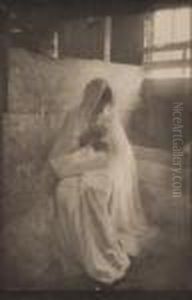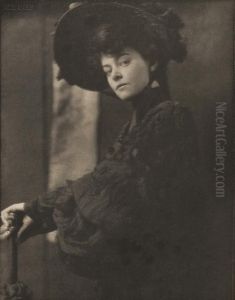Gertrude Stanton Kasebier Paintings
Gertrude Stanton Käsebier was an American photographer known for her evocative images of motherhood, powerful portraits of Native Americans, and her promotion of photography as a career for women. Born on May 18, 1852, in Des Moines, Iowa, she was named Gertrude Stanton, and she spent a significant part of her childhood in the American West. Her early experiences in the rugged landscapes and her exposure to various cultures would influence her later photographic work.
Käsebier married Eduard Käsebier in 1874, and the couple moved to Brooklyn, New York. Despite the traditional role of women in the late 19th century, Käsebier was determined to pursue an education in the arts. In her late 30s, after raising her family, she attended the Pratt Institute in Brooklyn to study painting and drawing. However, her interest in photography grew, leading her to pursue this new medium with great passion.
By the 1890s, Käsebier was deeply involved in the art of photography, and she opened her own studio in New York City by 1897. Her work quickly gained recognition for its artistic quality and emotional depth. She became known for her ability to capture the personality and essence of her subjects. One of her most famous series of portraits featured the Sioux Indians who were part of Buffalo Bill’s Wild West show. Käsebier's photos of Native Americans were celebrated for their dignity and humanity at a time when such depictions were rare.
Käsebier was also a prominent member of the Photo-Secession, a movement led by Alfred Stieglitz that aimed to promote photography as a fine art rather than merely a mechanical process. Her work was featured in Stieglitz’s influential publication, Camera Work, and she had several solo exhibitions at his gallery, 291. Käsebier was considered one of the most famous and respected photographers of her time, and she was a trailblazer for women in the field. She was a founding member of the Women's Professional Photographers Association of America and mentored many young women who desired to become photographers.
Throughout her career, Käsebier continued to push the boundaries of the medium, experimenting with different techniques and championing the pictorialist style of photography that emphasized the artistic aspects of the craft. Her legacy is defined by her profound impact on the recognition of photography as an art form, her advocacy for women photographers, and her masterful portraits that captured the complexity of the human spirit.
Gertrude Käsebier's life was one marked by a relentless pursuit of creative expression and an unwavering commitment to her art. She passed away on October 12, 1934, leaving behind a body of work that continues to inspire and influence photographers around the world.

